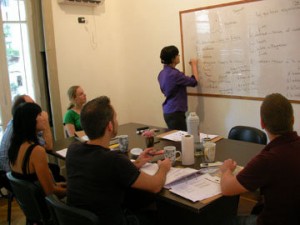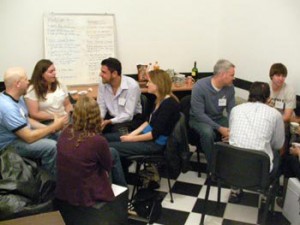When we arrived in Buenos Aires, Ryan knew a fair amount of Spanish from studying in high school and college but hadn’t spoken in ages, and I didn’t know more than what’s on a Mexican restaurant menu. Now, after ~3 months of class, we both speak decently and can get around just fine. Our conversations about politics and current news are a bit choppy sometimes, but we’re pretty excited to be able to have those conversations at all!
Through our quest to learn Spanish, we’ve tried a number of different resources, including:
- Group/private classes
- Fluenz (a computer program somewhat similar to Rosetta Stone)
- Traditional and electronic dictionaries
- Workbooks
- Computerized flashcards
- Lots of other stuff
In this post, we’ve covered our thoughts on classes and other interactive learning methods (stuff that’s most useful while you’re living in a Spanish-speaking country). In our next post on this topic, we’ll tell you what we think of a bunch of self-study resources that we’ve used.
GROUP CLASS
What it is: We’re not sure about other places, but in Buenos Aires, this generally means attending ~20 hours of class a week in a group of 4-7 students. Prices generally range $150-200 per week.
Pros: Lots of exposure to Spanish, relatively low cost per hour, opportunity to meet other students. Great way to learn grammatical structures and new vocab (particularly at more beginner/intermediate levels).
Cons: Can be lots of volatility in other students in the class (compatibility of learning style and level, weekly turnover of students), less time to practice speaking, not customized to your needs.
The verdict: We chose Vamos Spanish in Palermo as our school. We found that group classes were most effective at the beginner level, and it became more difficult to get as much out of classes at the more advanced levels. First, there are just a lot more beginners than advanced students, so you’re more likely to be in a class with compatible classmates who are learning the same things as you and have more or less the same speaking ability. At the more advanced levels, it’s more difficult to find compatible classmates, as the students have often studied different things and have different strengths – for example, one might be a very fluid speaker but mess up their subjunctive verb usage, while another speaks more or less correctly but lacks the fluidity and vocabulary of the other student. May not sound like a big deal, but this can be really frustrating for both students. Also, at the more advanced levels, typically what you need to work on is speaking, which is not what a group class is optimizing for (see notes on private lessons below).
A few words on class size: At first, the typical class max of 6-7 students sounded really small, but we soon realized that there’s a big difference between a class with 3-4 students and one with 6 or 7. We were lucky enough during our first few weeks of studying to be in very small classes (1-3 students). When our school unexpectedly tripled in size one week, we also got to experience classes with 6 students, and they felt completely different. In a larger class, the teacher is teaching the materials but can’t necessarily give individualized attention to make sure everybody understands. The larger classes focused more on doing exercises in small groups and less on talking – simple math: more people in the same amount of time means everybody gets to talk less. Friends at other schools have experienced the same – any more than ~5 students and it starts to feel more like a lecture and less like an interactive class.
PRIVATE LESSONS
What it is: One-on-one lessons with a private tutor. These can be arranged through Spanish school with one of the regular teachers (we’ve seen prices of ~$US25/hour) or through someone who only does private tutoring ($US10-15/hour generally). Private tutors may have training or not, while teachers at the Spanish schools generally have to have some sort of training to teach.
Pros: Customized, one-on-one attention, lots of practice speaking, don’t have to worry about whether other students are compatible with your skill level and learning style.
Cons: Generally fewer hours of exposure to Spanish for the same price (since privates are more expensive), no space-out time since you’re the only one in the class.
The verdict: We started supplementing our group classes with private tutoring after about a month and a half and found that this was a great way to (1) get practice speaking (which was our primary goal in studying Spanish) and (2) get focused help/practice on the specific things we were messing up. We felt that we needed more practice using the things we were learning in our group classes in order to be able to more quickly incorporate them into our speaking – something you can’t really do in a group class, since you’re sharing that time block with multiple other students who also want their chance to speak. And at the more advanced levels for the reasons mentioned above, a group class can become less effective. We both saw our speaking ability improve significantly by working one-on-one with a tutor and think we would shift the mix of our study time toward this method (and away from group classes) in the future.
LANGUAGE EXCHANGE
What it is: Meeting with native Spanish speakers who want to practice English (or your native language) and spending half the time talking in each language. These can be group events (our Spanish school hosted one each week; most groups charge small fee) or one-on-one (generally free).
Pros: Opportunity to practice speaking and meet native speakers.
Cons: Language partners aren’t trained teachers so may not correct you or teach you “correct” Spanish. More notably with group exchanges, you can tend to have the same conversation over and over (where you’re from and why you wanted to learn Spanish, etc.).
The verdict: We had high hopes for this one but didn’t end up using it much. The group exchanges we tried had an imbalance of English vs. Spanish speakers, and we found that group chats were dominated by the most advanced speakers, so beginners/intermediates didn’t get to do much more than listen in. We didn’t try one-on-ones, partly because finding a language buddy seemed hard and we are lazy.
PART 1 SUMMARY
Overall, these are all useful methods to learn Spanish and the best way to take advantage of living in or visiting a Spanish-speaking country for an extended period of time. For us, the mix shifted over time – heavier on group classes in the beginning and more private lessons as we have become more advanced.
We’ll post again soon about the different tools we used for self-study – hope this is useful!



Pingback: Tweets that mention How to Learn Spanish (Part 1) | Consulting Rehab -- Topsy.com
Great article.. It got me thinking about lessons again after two years of stumbling around the language in ecuador.. Thanks a lot
http://savvyroundtheworld.wordpress.com
Hey, thanks for your comment. Just checked out your site and it looks great! Would love to get up to Ecuador one of these days and will definitely make use of all of your great tips when we do. Thanks!